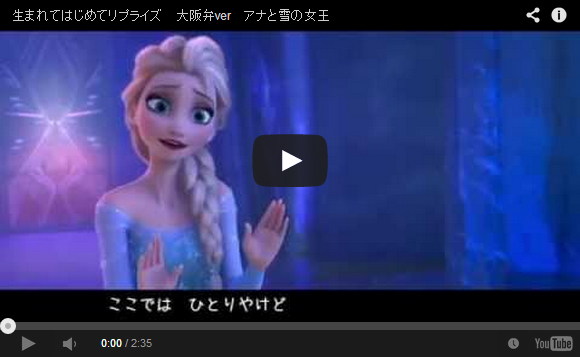
It all started with the Japanese version of “Let it Go”, the hit song from Disney’s latest animated movie Frozen. But that wasn’t the only song to be localized, and now amateur singers are getting even more local with creative versions of Frozen’s songs in their own regional dialects. Join us after the jump for two of the best.
Dialects in Japan are serious business. It’s not just a matter of accent or pronunciation; the grammatical structure and vocabulary can also both change dramatically, to the extent that sometimes people born in the same country and supposedly speaking the same language can’t even understand each other.
The Japanese release of Frozen went so far as to dub the songs with original Japanese-language versions, but for some people that just wasn’t native enough. Often overshadowed by “Let It Go”, the duet that the two young princesses share when Anna comes to Elsa’s ice castle in the mountains to beg for her to come home, “For the First Time in Forever (Reprise)”, is also brilliant. It’s also much more suited to showing showing off casual dialectal differences in the back-and-forth between the two sisters. Now we’re seeing regional dialect versions of the song popping up on YouTube, which have the scene unfolding entirely in the style of the chosen area, from the spoken dialogue through to the singing.
The first of these was a Hakata-ben version. In Japanese, using ‘ben‘ after a place name denotes the dialect of that area, and in this case Hakata is an area of Fukuoka City. The singer, known only as Edamame, performs the parts of both Anna and Elsa with gusto, and in a great touch she also replaces the name of the kingdom, Arendelle, with Hakata! The video has already racked up over one million views.
Now we also have one in Osaka-ben, arguably the most famous dialect in Japan, spoken by people in the Osaka region and often heard from the lips of famous comedians. The song has been produced single-handedly by Osakan singer/songwriter Kanna, who was inspired to make it after Edamame’s Hakata-ben version became popular.
Her voice is just as good as Edamame’s; they both sound like pros! And we can’t get over how great she is at differentiating between the parts of the two sisters.
I’m sure we’ll be seeing many more of these in the weeks to come! Personally, I’d especially like to hear an Okinawan version.
Can you hear the differences between the dialects?
Source: RocketNews24 Japan
Images/Videos: YouTube
[ Read in Japanese ]